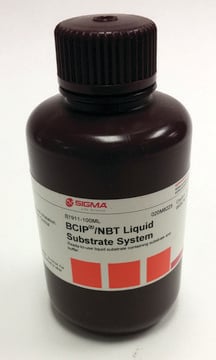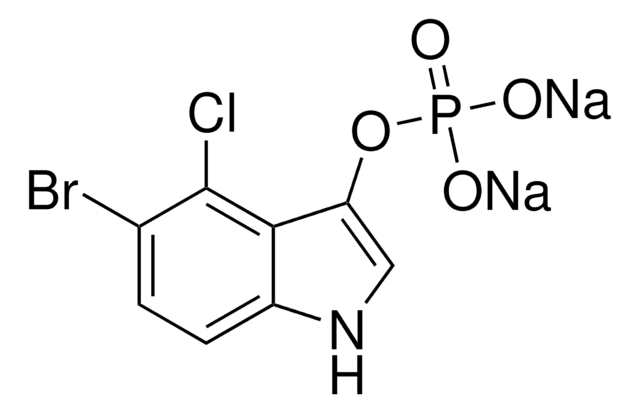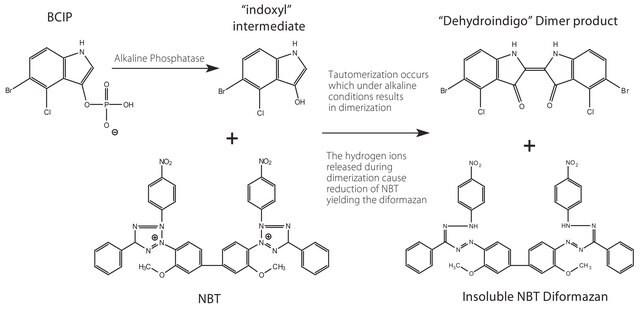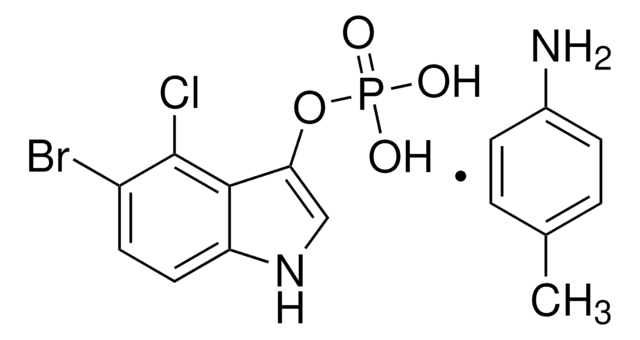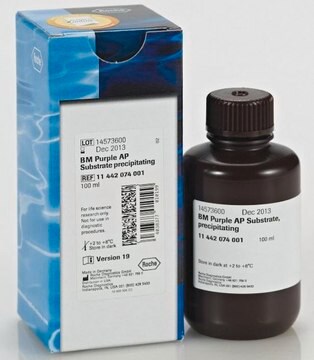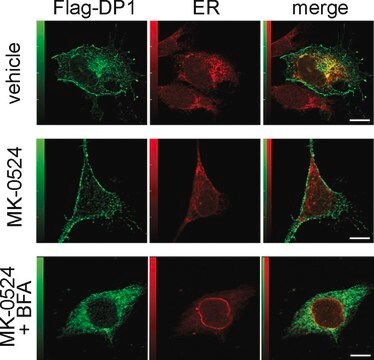72091
NBT-BCIP® solution
BioReagent, suitable as substrate for alkaline phosphatase in dot blots
Sinonimo/i:
BCIP®/NBT, NBT-X-phosphate
About This Item
Prodotti consigliati
Grado
suitable as substrate for alkaline phosphatase in dot blots
Livello qualitativo
Nome Commerciale
BioReagent
Forma fisica
liquid
Solubilità
0.1 M Tris-HCl, pH 7.4: 0.0175 mL/mL, clear
applicazioni
diagnostic assay manufacturing
hematology
histology
Temperatura di conservazione
2-8°C
Stringa SMILE
[Cl-].[Cl-].Cc1ccc(N)cc1.OP(O)(=O)Oc2c[nH]c3ccc(Br)c(Cl)c23.COc4cc(ccc4-[n+]5nc(nn5-c6ccc(cc6)[N+]([O-])=O)-c7ccccc7)-c8ccc(c(OC)c8)-[n+]9nc(nn9-c%10ccc(cc%10)[N+]([O-])=O)-c%11ccccc%11
InChI
1S/C40H30N10O6.C8H6BrClNO4P.C7H9N.2ClH/c1-55-37-25-29(13-23-35(37)47-43-39(27-9-5-3-6-10-27)41-45(47)31-15-19-33(20-16-31)49(51)52)30-14-24-36(38(26-30)56-2)48-44-40(28-11-7-4-8-12-28)42-46(48)32-17-21-34(22-18-32)50(53)54;9-4-1-2-5-7(8(4)10)6(3-11-5)15-16(12,13)14;1-6-2-4-7(8)5-3-6;;/h3-26H,1-2H3;1-3,11H,(H2,12,13,14);2-5H,8H2,1H3;2*1H/q+2;;;;/p-2
GDPIIVBVMSORRQ-UHFFFAOYSA-L
Cerchi prodotti simili? Visita Guida al confronto tra prodotti
Stato fisico
Altre note
Note legali
Prodotti correlati
Codice della classe di stoccaggio
10 - Combustible liquids
Classe di pericolosità dell'acqua (WGK)
WGK 2
Punto d’infiammabilità (°F)
152.6 °F - closed cup
Punto d’infiammabilità (°C)
67 °C - closed cup
Dispositivi di protezione individuale
Eyeshields, Gloves, type ABEK (EN14387) respirator filter
Certificati d'analisi (COA)
Cerca il Certificati d'analisi (COA) digitando il numero di lotto/batch corrispondente. I numeri di lotto o di batch sono stampati sull'etichetta dei prodotti dopo la parola ‘Lotto’ o ‘Batch’.
Possiedi già questo prodotto?
I documenti relativi ai prodotti acquistati recentemente sono disponibili nell’Archivio dei documenti.
I clienti hanno visto anche
Il team dei nostri ricercatori vanta grande esperienza in tutte le aree della ricerca quali Life Science, scienza dei materiali, sintesi chimica, cromatografia, discipline analitiche, ecc..
Contatta l'Assistenza Tecnica.